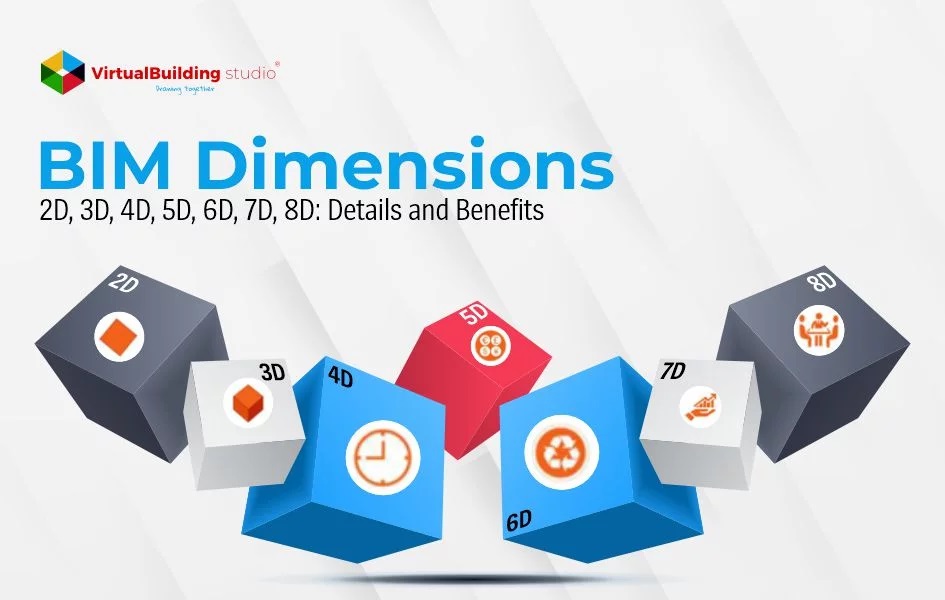BIM Dimensions – 2D, 3D, 4D, 5D, 6D, 7D, 8D: Details and Benefits
BIM Dimensions – 2D, 3D, 4D, 5D, 6D, 7D, 8D: Details

What are BIM dimensions?
The revolutionary leap towards transforming a 2D CAD drawing of a project to an information-rich 3D model has drastically impacted the design process. The evolution benefits the stakeholders by adding different aspects to the modeling process with different dimensions.
Exploring the Seven Types of BIM Dimensions
2D, 3D, 4D, 5D, 6D, and 7D, each of these BIM dimensions have their unique purpose and benefits. These are useful in finding out the project cost, timeline, and sustainability graph for future purposes. We will discuss below each of the dimensions in detail.
2D BIM Modeling
A digital geometric model that constitutes an X and Y axis related to other information about the project falls under 2D BIM. The CAD systems used earlier were 2D models where plans and sections were created digitally more accurately and quickly than manual processes.
3D BIM Modeling
A digital geometric model that constitutes an X, Y, and Z axis associated with other information about the project falls under 3D BIM. The AEC industry widely uses the technology of 3D BIM modeling.
- The 3D BIM dimension induces accuracy and efficiency in the project and lessens the risk of clashes occurring on the projects.
- It helps in better internal coordination among the design team and the sharing of design expectations.
- The transparency of work from the beginning eliminates instances of rework and revisions.
4D BIM Modeling
- It caters to improved site planning and scheduling optimization.
- It articulates a seamless communication and collaboration between the architects, contractors, engineers, and other related stakeholders.
- It prepares the team in advance for every step of construction, also eliminating costly delays.
5D BIM Modeling
- It induces the process with real-time cost visualization and is notified about the changes in costs throughout construction.
- It prepares a simplified list of predicted or actual project expenditures over time, recorded using cost or budgetary analysis.
- This BIM dimension eliminates the possibility of budget offshoot through regular cost reporting and monitoring.
6D BIM Modeling
- It monitors data about project status, maintenance, warranty information, technical specifications, and other details required in the future.
- It collates all relevant data to facility management in one place, improving the quality of service delivery for the project lifecycle.
7D BIM Modeling
7D BIM helps in analyzing the energy consumption estimates about a building and caters to the sustainability quotient of a design. It helps in quantifying the energy estimates at initial design stages, taking the AEC sector to an advanced level that is beyond just focusing on the upfront project costs.
- It caters to reduced energy consumption throughout the project lifecycle.
- It helps the stakeholders in faster decision-making regarding the component selection.
- It facilitates the analysis of the economic and operational aspects of a building.
8D BIM Modeling
- It prevents accidents and incidents by introducing safety elements into the design.
- It enables the designers to execute a thorough risk assessment of the building they are designing.
Conclusion
Source: https://www.virtualbuildingstudio.com/bim-dimensions-2d-3d-4d-5d-6d-7d-8d/












